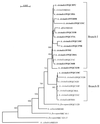Geographical segregation of the neurotoxin-producing cyanobacterium Anabaena circinalis
- PMID: 11010900
- PMCID: PMC92326
- DOI: 10.1128/AEM.66.10.4468-4474.2000
Geographical segregation of the neurotoxin-producing cyanobacterium Anabaena circinalis
Abstract
Blooms of the cyanobacterium Anabaena circinalis are a major worldwide problem due to their production of a range of toxins, in particular the neurotoxins anatoxin-a and paralytic shellfish poisons (PSPs). Although there is a worldwide distribution of A. circinalis, there is a geographical segregation of neurotoxin production. American and European isolates of A. circinalis produce only anatoxin-a, while Australian isolates exclusively produce PSPs. The reason for this geographical segregation of neurotoxin production by A. circinalis is unknown. The phylogenetic structure of A. circinalis was determined by analyzing 16S rRNA gene sequences. A. circinalis was found to form a monophyletic group of international distribution. However, the PSP- and non-PSP-producing A. circinalis formed two distinct 16S rRNA gene clusters. A molecular probe was designed, allowing the identification of A. circinalis from cultured and uncultured environmental samples. In addition, probes targeting the predominantly PSP-producing or non-PSP-producing clusters were designed for the characterization of A. circinalis isolates as potential PSP producers.
Figures




References
-
- Anderson D M. Red tides. Sci Am. 1994;271:62–68. - PubMed
-
- Baker P. Anabaena circinalis. In: Tyler P, editor. Identification of common noxious cyanobacteria, part 1. Nostocales. Melbourne, Australia: Melbourne Water Corporation; 1992. pp. 39–45.
-
- Baker P D, Humpage A R. Toxicity associated with commonly occurring cyanobacteria in surface waters of the Murray-Darling basin, Australia. Aust J Mar Freshwater Res. 1994;45:773–786.
-
- Baker P D, Humpage A R, Steffensen D A. Cyanobacterial blooms in the Murray-Darling basin: their taxonomy and toxicity. Report 8/93. Adelaide, Australia: Australian Centre for Water Quality Research; 1993.
-
- Bowling L. Occurrence and possible causes of a severe cyanobacterial bloom in Lake Cargelligo, New South Wales. Aust J Mar Freshw Res. 1994;45:737–745.
Publication types
MeSH terms
Substances
Associated data
- Actions
- Actions
- Actions
- Actions
- Actions
- Actions
- Actions
- Actions
- Actions
- Actions
- Actions
- Actions
- Actions
- Actions
- Actions
- Actions
- Actions
- Actions
- Actions
- Actions
- Actions
- Actions
- Actions
- Actions
- Actions
- Actions
- Actions
LinkOut - more resources
Full Text Sources
Molecular Biology Databases
Research Materials
Miscellaneous

